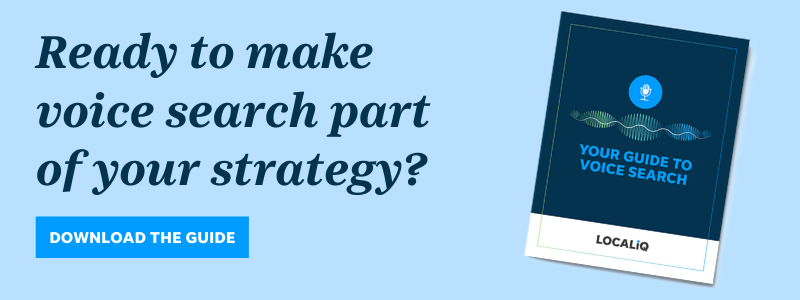When’s the last time you used voice search? If you’re like a third of adults, it was sometime in the past month. Thirty-three percent of consumers used voice search at least monthly as of early 2019, and that number is only expected to rise.
Whether on desktop, mobile, or smart speaker, Google voice search is becoming a popular way to find answers to queries online. So it’s easy to see why brands should take an interest in how Google voice search works. Let’s take a closer look.
How Voice Search Works for Consumers
Let’s start with how consumers experience voice search. Google voice search can be used on any type of device: desktop, mobile, or smart speaker. On desktop, consumers simply press the microphone button to start a voice search. On mobile or smart speakers, the phrase “Okay, Google” will trigger the device to listen to your query.
Once the consumer asks their question, Google will display results. On a desktop or mobile, you’ll see results on the page, and with smart speakers, the voice assistant will give you results verbally. If you’re unhappy with the first result, you can ask for additional options until you find the one that’s right for you.
More and more consumers today are relying on voice search specifically for local queries. In fact, Google reports that searches for “store open near me” increased 250% over the last two years.
And, people are still relying on voice search during the coronavirus pandemic, including asking their voice assistants what to do if they think they may have coronavirus and searching for information hands-free while out and about.
How Voice Search Works on Google
Now that we understand a consumer’s experience when using voice search, it’s helpful to know what’s happening behind-the-scenes on the search engine. Google is famously tight-lipped about exactly how it displays results in search engine results pages (SERPs), and it’s similarly hush-hush about all of the factors that go into its voice search results. However, we do know some of the factors that influence where and how brands appear in search.
Google’s Hummingbird update was a huge shift in the way the search engine handled queries, and it’s changed the trajectory of search as we know it. The Hummingbird update helped Google’s search engine understand the semantics, or intent, behind a given search. Rather than looking at queries as word salad and leaving the machine to pull results relevant to each of the individual words, Hummingbird allowed Google’s algorithm to consider the whole phrase and to consider the meaning behind the query. And, more recently, Google released its BERT update, which helps computers better understand how we speak, think, and search.
Often, the way we search on Google via text is different from the way we’d search with voice. Semantic search allows Google to understand the intent behind any search better than ever before. But it’s particularly relevant in those voice searches, where consumers speak in plain English and may use colloquialisms.
With Hummingbird and BERT, Google’s algorithm is better positioned to understand the meaning behind the spoken words. It serves up results that might be related to synonyms of words we searched or pages that it thinks speaks to the intent of our query.
3 Ways to Make Voice Search Work for Your Business
Monitoring both the way consumers use voice search and how Google’s algorithms and systems manage the voice search backend are the brands that rely on it to get discovered. All businesses want to be the one that’s served up as a result to a query in voice search.
That means it’s important for brands to consider the ways consumers rely on voice search and how Google serves up results. Only when you understand that interplay can you optimize your brand for voice search. Here are three of the most important factors for brands to consider.
1. Knock Your SEO Out of the Park
Having a strong SEO strategy in place is critical to getting noticed in any kind of search, voice or text. But it’s particularly important for voice searchers.
Think about how you use voice search in your own life – it’s typically when you’re on the go or in the middle of something and looking for a quick answer. Voice searchers don’t have time to sort through pages of responses to their query, so you want to ensure your brand shows up in relevant results. Aside from having a paid search presence, the best way to improve your performance on Google is to optimize your website for local search.
Start by creating a website that’s fast and mobile-friendly. These are two known factors Google considers when determining which sites to display in SERPs. If you and a competitor have equally great content, Google will give you the edge if your site is faster and looks better on mobile.
Making sure that your metadata and content are optimized for local search is also critical. Clearly state what it is that your business does, and include your location, hours, and contact information front-and-center on your website. When Google can easily scan your site and find this information, they’re more likely to list you in local search results.
2. Aim for Position Zero
The only thing better than coming out on top in search results is landing position zero. This is marketer talk for the featured snippet on Google – the box you sometimes see at the top of results, which answers your question right on the search engine itself by pulling information from a given website.
Google often uses featured snippets for process-based searches (i.e., “How do I…?”). And voice assistants often use these snippets to inform their answers. If you can be the business to answer a question on Google, you can gain credibility and earn trust with your audience.
To snag position zero, start by honing-in on long-tail keywords and queries that make sense for your business. If you’re a wedding planner, you might aim to land in featured snippets for a query like, “How do I find a wedding venue?” From there, writing content in plain English that clearly answers the question is a great way to get noticed by Google and land the coveted spot.
3. Get on Local Listings
Beyond your own website, it’s crucial you establish a presence for your business on local listings sites. Local listings directories include Yelp, Facebook, and Google My Business.
On these sites, you can list your business hours, contact information, and a link out to your website. It’s also a place for you to gather great reviews from happy customers. Local listings are especially important now when your hours of operation might be different and the way you’re operating may have changed since the beginning of the year.
Additionally, local listings sites can be a source of information for voice assistants.
Each year, Google voice search plays a more prominent role in the way consumers discover new brands. As a business owner, it’s important you understand how voice search works, what consumers use the tool for, and how you can optimize your brand’s online presence to stand out. And, right now is a great time to start focusing on optimizing your web presence for voice search as communities and businesses begin reopening. For more information, give us a call today!
Related Articles
What Are Local Listings and Why Do You Need Listings Management?
4 Reasons You Can’t Ignore Voice Search
Super Effective Marketing Trends to Give Your Business an Edge Right Now







